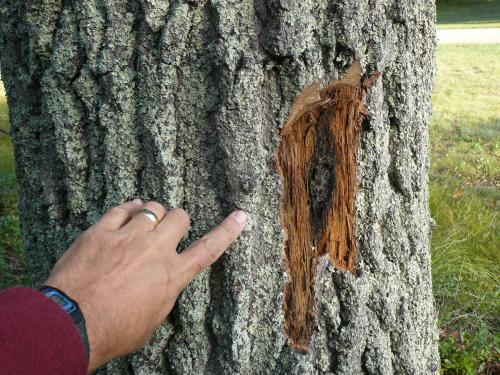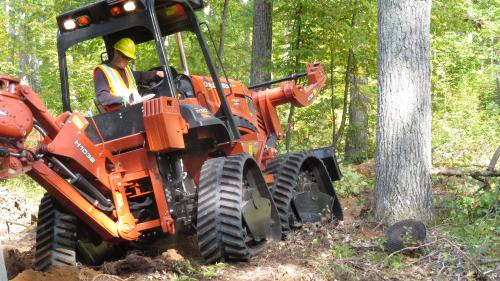Oak wilt disease
Mid-April to mid-July is the season to avoid wounding oaks. Oak wilt is an exotic disease causing increased levels of mortality in Michigan. Once in an oak stand, the disease will kill most of the oaks and treatment is expensive.

With spring comes renewed concern about oak wilt, as the disease becomes active. The disease is well-established across much of the Michigan oak landscape. So, caution is warranted where ever oak occurs.
Oak wilt is fatal for all the species in the red oak group; those oaks with pointy-tipped leaves. The white oak group is less vulnerable; those oaks with round-tipped leaves. Oak wilt can be recognized by rapid wilting and loss of leaves beginning at the top of the tree. Binoculars can help with early detection. The entire tree dies within a few weeks.
Oaks killed last year will display spore mats with pressure pads that rupture the bark, usually evidenced by a slight swelling and a vertical crack. These are the trees that are particularly dangerous.
A group of sap-feeding beetles is attracted to these sweet-smelling spore mats. The beetles can move spores to uninfected areas. Once an oak stand is infected, the disease spreads underground through roots and root grafts until all the oaks are dead. The exotic fungus requires live tissue, so, once the trees are dead, the fungus is gone, too.
Avoid wounding oaks from mid-April to mid-July, should an oak be wounded, immediately painting the wound is recommended. The beetles can potentially find fresh wounds in less than a half-hour. This is also a poor time of the year for clearing rights-of-ways and roadsides when oaks are present.
The disease can easily be transported in logs and firewood. Harvested oak from infected stands should either be immediately turned into lumber, burned, or tightly covered by tarps. Oak wilt is one more reason why the movement of firewood should no longer be done without consideration of spreading exotic insects and diseases.
Oaks are affected by other disease organisms, too. Browning leaves concentrated in the lower portion of a tree often result from a foliar disease called anthracnose. It’s common for many tree species, especially with wet spring weather.
Recent droughts, going back to 2005, have caused enough stress to allow two-lined chestnut borers and Armillaria root rot to attack oaks, especially older oaks and those growing on marginal sites. Sometimes this can cause top-down leaf browning but trees seldom die within just a few weeks, as they do with oak wilt. Heavy gypsy moth defoliation can mask the effects of oak wilt. Dry spring weather favors gypsy moth larvae survival.

Oak wilt spore mat and pressure pad
The spread of oak wilt occurs both overland and underground. Certain sap-feeding beetles can carry spores to healthy trees during the growing season. Oaks, particularly red oaks, have root systems that graft together, allowing the movement of the fungus to easily move from tree to tree.
Oak wilt can be treated but the process is expensive and can result in significant visual change. Treatment requires the elimination of both overland and underground pathways. The alternative is losing all the oaks in an area (examples abound). Treatment in residential areas is particularly troublesome and sometimes not possible.
Root grafts are broken using a deep vibratory plow. However, this doesn’t work as reliably in the boulder-filled country around IronMountain. Overland spread is eliminated by removing all oak trees within the infected epicenter.
Vibratory plow severing oak root grafts around a disease epicenter.
Michigan State University Extension and the Michigan DNRE are, once again, pursuing a USDA Forest Service grant to pay for the identification and trenching of oak wilt of affected sites. However, tree removal and proper disposal remain the responsibility of the landowner.
Once an oak is infected it cannot be saved. There are rather expensive chemical treatments available for individual high-value oaks that are not yet infected, but the treatment is neither guaranteed to prevent oak wilt and must be repeated over time.
The best way to deal with oak wilt is prevention. Avoid wounding oaks from April to August. Don’t prune during that time. Be careful with the lawnmower and weed-whacker. If possible, put off construction activities around oaks until the late summer.
If an oak wound does occur in the spring, this would be one of the few reasons to apply a wound sealant. In most other cases, wound sealants are not recommended. However, when the sap-feeding beetles are active, immediate application of a sealant will prevent them from reaching freshly exposed tissues.
Should your oak trees display symptoms of oak wilt or if you would like more information, contact me at cookwi@msu.edu, 906-786-1575 or at my office in the Forest Biomass Innovation Center near Escanaba. County Extension offices and Conservation Districts also have information.



 Print
Print Email
Email



